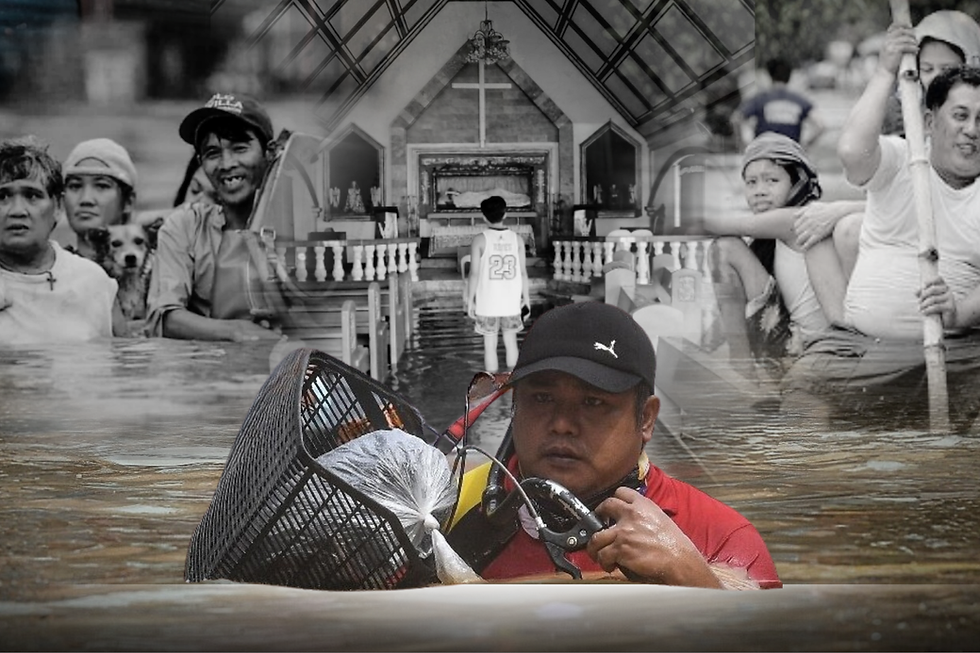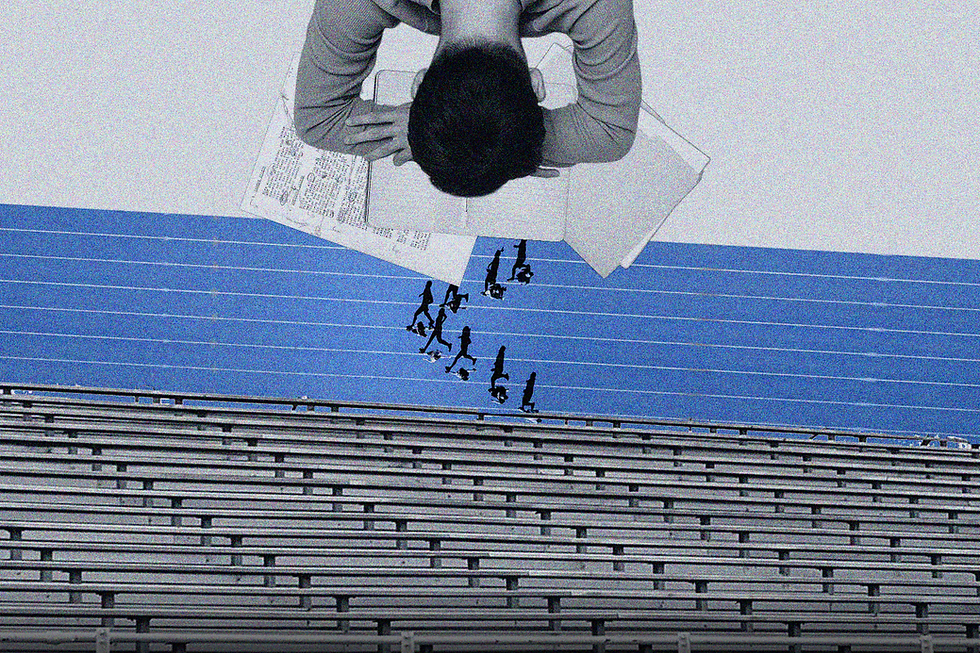𝗔𝗳𝘁𝗲𝗿 𝘁𝗵𝗲 𝗪𝗮𝘁𝗲𝗿𝘀 𝗥𝗲𝗰𝗲𝗱𝗲: 𝗩𝗼𝗶𝗰𝗲𝘀 𝗳𝗿𝗼𝗺 𝘁𝗵𝗲 𝗙𝗹𝗼𝗼𝗱𝗲𝗱 𝗦𝘁𝗿𝗲𝗲𝘁𝘀
- The Communicator
- Oct 28
- 5 min read
The rain begins as a soft rhythm against the rooftops, which some people find comforting. But for some residents in the Philippines, they don’t just reach for umbrellas—they brace for another flood. For many of them, the sound of heavy rain is not a comfort but a warning. The water rises quietly at first, seeping into the streets, then into homes, until life once again floats on uncertainty.

Everyday Life Beneath the Floodline
In flood-prone communities, rain is rarely something to enjoy. Each dark cloud brings a quiet dread, and every drop that hits the ground feels like a countdown. In each place, life moves in tune with the weather. The first sign of heavy rain sends families into motion—lifting furniture, unplugging appliances, or placing valuables in plastic containers. For them, rainfall is not a passing moment; it’s a reminder of what could return at any time.
Shane Maghanoy, a resident of Parañaque City, shared her feeling of uncertainty and the struggle of life during the rainy months. For her, it is a test of endurance—one that disrupts not only routines, but also hopes. As a student, she’s learned to adapt to flooded streets and unpredictable weather, though it never gets easier.
“Flooding is making our life harder because it affects different things such as work, school and any activities that a person might need to accomplish,” she stated.
Isabella Generol, another resident from Parañaque City, shared the same sentiment, recalling how difficult it is to commute from her home to school during heavy rains. The uncertainty of class suspensions adds to her frustration, leaving her to decide each morning whether to risk wading through floodwaters or wait for announcements that often come too late.
“Mahirap pumasok sa school lalo na’t sa Manila ako pumapasok,” she stated. “Sometimes hindi pa nagsususpend ng sabay ang Parañaque at Manila.”
For people like Shane and Isabella, rainfall is not just a mild inconvenience, but rather a test of patience and resilience. However, while the water continues to rise and disrupt the flow of daily life, they’re still pushing forward and adapting to this life, or perhaps a way of life, in rhythm with the rain. It’s a way of life and a way of being in these flood-prone neighborhoods.
Anchored in Faith and Family
In times when the water rises, faith is the only thing that doesn’t drown. When streets are submerged under brown water, prayer replaces panic. Many residents rely on faith for support, learning that every storm passes eventually. Maghanoy stated, “With prayer, I stay motivated despite the flooding,”
Julianne Oriendo, another Parañaueña, also comes from the simple assurance of family safety. When help feels a world away—spirit, faith, and family become their lifeline. “Iniisip ko na huhupa rin ito at makababangon kaming muli,” she said.
Faith and family are anchoring. The belief that no matter how high the water rises, the human spirit is always afloat.
When the Water Falls, So Do Walls—and Rise Again
When heavy rain begins, residents already know what to do. Some pack up and evacuate early, while others stay to protect their homes. For most families, preparation has become routine—gathering emergency kits, moving furniture to higher ground, or retreating to the second floor to wait it out. Each home has its own ritual of readiness, shaped by years of living with the certainty of floods.
When the waters finally subside, the real work begins. Streets are blanketed in mud, debris floats by, and the air smells of stagnant water. Armed with brooms and pails, residents sweep, scrub, and clean—again and again, storm after storm. It’s exhausting, but perseverance runs deep.
Some survey the inside of their houses to assess damage and determine if walls and furniture can be salvaged. Others check on neighbors and family. In all corners of the community, people can be seen mopping up, hanging clothes to dry in the sunshine, and trying to establish normalcy again.
Even with floods coming and going, their faith and hope give the community stability. Many people pray because they believe that every storm will eventually pass. For others, just having their family safe will get them through. They have learned through these experiences to take care of the environment, stay prepared, and choose responsible leaders.
“We must always work together to function as a society,” said Vikram Jehlo Dela Cruz, a resident of Malabon City.
Residents’ Call to Action
For years, people in communities prone to flooding have adapted to waters that rise and fall. But endurance is no longer enough. They think the real change will only come from the leadership that acts on it, rather than just promising. Maghanoy stated that the government can help: “Raising awareness and creating programs that focus on our environment and how to prevent these types of situations,” she said.
Others are asking for tangible action—better drainage systems, raised roadways and a schedule for canal clean-up regularly. “Mahalagang turuan at paalalahanan ang mga tao tungkol sa tamang pagtapon ng basura," said Generol, pointing out that proper waste disposal is the only way to prevent flooding. For them, they want solutions that have mixed infrastructure, discipline and cooperation.
Still, there is deep frustration. So many people are tired of the promise that disappears as fast as the water does. “They should actually use the flood control budget, for the flood,” said Dela Cruz.
They know that resilience has its limits—and the government must now rise with its people. Even with frustration, there is still hope, silently flowing toward one message that continues to bring them all together.
From the Flood, a Message of Hope
At the heart of their resilience lies a question that lingers: Will things ever change?
While inundation might always be woven into the fabric of their lives, those who reside below water level have never allowed despair to envelop them. Their narratives are not merely defined by suffering, but are rich with resilience. “Living in a flood-prone community can be tough,” said Maghanoy. “But, if you look closely, there is still a glimmer of hope.”
They have come face to face with the water, overcome it, and found joy in simple things: a dry meal, neighbors helping each other, a morning when the streets finally drained. Even as history repeats itself, they cling to hope for the future—not out of ignorance, but of faith. “Buhay sa komunidad na madalas bahain ay hindi madali,” said Generol. “Pero sa kabila noon, nandoon ang malasakit at pagtutulungan.”
Their message is clear: we all play apart in this cycle, whether we are steeped along the river or far from it. The floods served a very real purpose in reminding us there is more to resilience than merely surviving—there is the value of caring for one another and the world in which we all exist. And, when the waters rise again, as they will, they too will stand tall again, drenched, scarred, and wholly hopeful.
In every story shared, in every life rebuilt, their voices rise above the flood. They remind us that while storms may return, so will their courage, flowing endlessly through the flooded streets they call home.
Article: Jae Juson
Graphics: Keren Hope De Leon







Comments